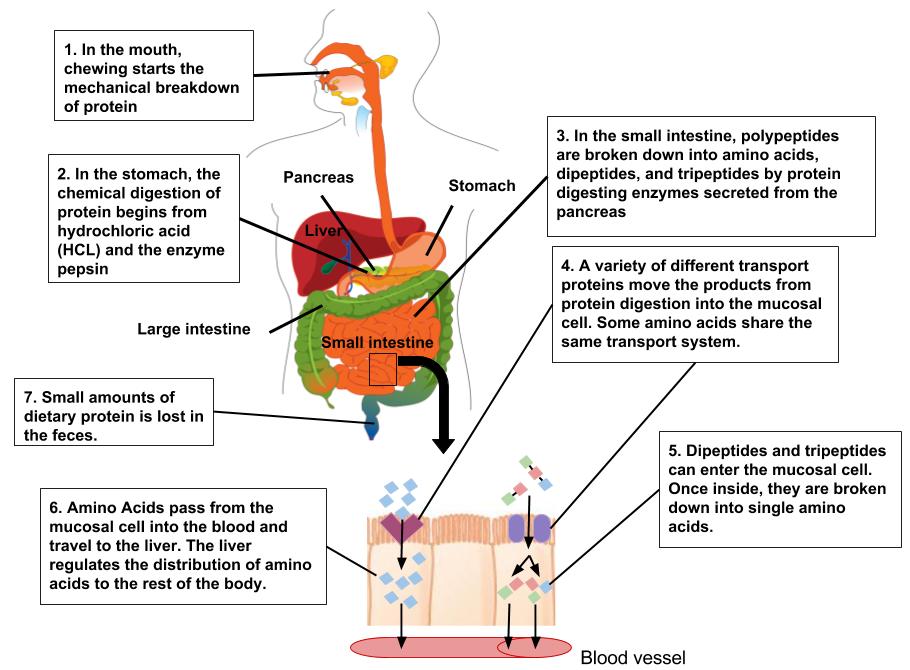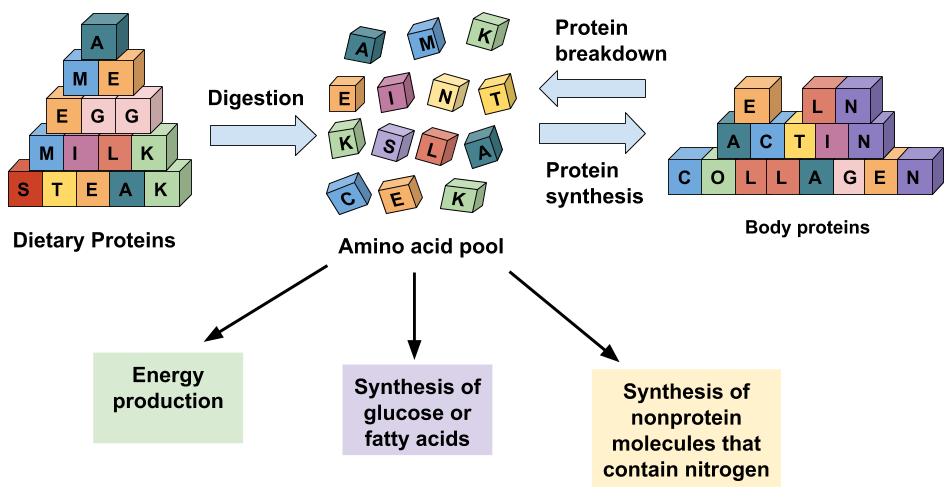Protein Digestion and Absorption
How do the proteins from foods get processed into amino acids that cells can use to make new proteins? When you eat food the body’s digestive system breaks down the protein into the individual amino acids, which are absorbed and used by cells to build other proteins. We previously discussed the general process of food digestion. Let’s follow the specific path that proteins take down the gastrointestinal tract and into the circulatory system (Figure 6.7 “Digestion and Absorption of Protein”). Eggs are a good dietary source of protein and will be used as our example to describe the path of proteins in digestion and absorption. One raw, hard-boiled, scrambled, or fried egg supplies about six grams of protein.

(Source: University of Hawaii @ Manoa, Allison Calabrese, CC-BY-NC-SA)
From the Mouth to the Stomach
The first step in egg digestion (or any other protein food) involves chewing. The teeth begin the mechanical breakdown of the food into smaller pieces that can be swallowed. The salivary glands provide saliva to aid swallowing and the passage of the partially mashed egg (bolus) through the esophagus, which enters the stomach through the esophageal sphincter. The stomach releases gastric juices containing hydrochloric acid and the enzyme, pepsin, which initiate the breakdown of the protein. The powerful mechanical stomach contractions churn the partially digested protein into a more uniform mixture called chyme. Protein digestion in the stomach takes a longer time than carbohydrate digestion, but a shorter time than fat digestion. Eating a high-protein meal sufficiently increases the time required to break down the meal in the stomach. Food remains in the stomach longer, making you feel full longer.
From the Stomach to the Small Intestine
The stomach empties the chyme containing the broken-down egg pieces into the small intestine, where most protein digestion occurs. The pancreas secretes digestive juice that contains more enzymes that further break down the protein. The two major pancreatic enzymes that digest proteins are chymotrypsin and trypsin. The cells lining the small intestine release additional enzymes that break apart the smaller polypeptides into the individual amino acids. The amino acids are transported from the intestinal lumen through the intestinal cells to the blood. This movement of individual amino acids requires special transport proteins and the cellular energy molecule, adenosine triphosphate (ATP). Once the amino acids are in the blood, they are transported to the liver. Like other macronutrients, the liver is the checkpoint for amino acid distribution.
Amino Acids Are Recycled
Just as some plastics can be recycled to make new products, amino acids are recycled to make new proteins. All cells in the body continually break down proteins and build new ones, a process referred to as protein turnover. Every day, over 250 grams of protein in your body are dismantled and 250 grams of new protein are built. To form these new proteins, amino acids from food and those from protein destruction are placed into a “pool.” However, it is not a literal pool; when an amino acid is required to build another protein, it can be acquired from the additional amino acids within the body. Amino acids are used not only to build proteins, but also to build other biological molecules containing nitrogen, such as DNA, RNA, and, to some extent, to produce energy. It is critical to maintain amino acid levels within this cellular pool by consuming high-quality proteins in the diet, or the amino acids needed for building new proteins will be obtained by increasing protein destruction from other tissues within the body, especially muscle. This amino acid pool is less than one percent of total body-protein content. Thus, the body does not store protein as it does with carbohydrates (as glycogen in the muscles and liver) and lipids (as triglycerides in adipose tissue).

(Source: University of Hawaii @ Manoa, Allison Calabrese, CC-BY-NC-SA)
Amino acids in the cellular pool come from dietary protein and the destruction of cellular proteins. The amino acids in this pool need to be replenished because amino acids are used to make new proteins, energy, and other biological molecules.
Learning Activities
Technology Note: The second edition of the Human Nutrition Open Educational Resource (OER) textbook features interactive learning activities. These activities are available in the web-based textbook and are not in downloadable versions (EPUB, Digital PDF, Print_PDF, or Open Document).
Learning activities may be used across various mobile devices; however, for the best user experience, it is strongly recommended that users complete these activities using a desktop or laptop computer.
The molecules from which proteins are built, each protein being composed of a specific sequence of linked amino acids.
The system of organs that are responsible for ingestion, digestion, and absorption of food and the discharge of residual wastes.
A class of compounds composed of linked amino acids. They contain carbon, hydrogen, nitrogen, oxygen, and sometimes other atoms in specific configurations.
A protein-digesting enzyme found in the stomach.
A mixture of partially digested food and gastric secretions in the stomach.
A protein molecule that speeds up or accelerates specific chemical reactions without changing itself.

